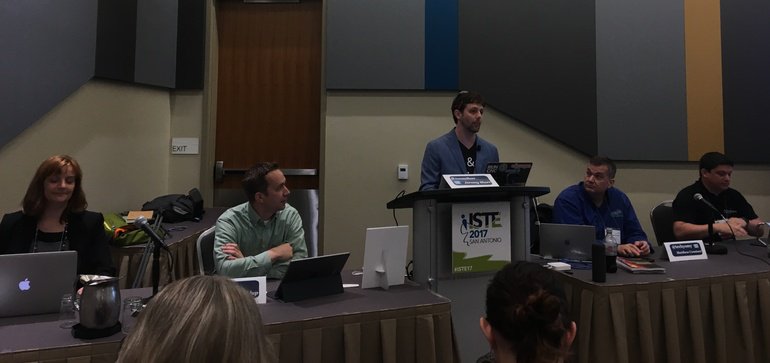
4 key takeaways from ISTE’s ‘CTO Boot Camp’ panel
4 key takeaways from ISTE’s ‘CTO Boot Camp’ panel https://csuiteold.c-suitenetwork.com/wp-content/uploads/2017/07/4-key-takeaways-from-istes-cto-boot-camp-panel.jpg 770 363 C-Suite Network https://csuiteold.c-suitenetwork.com/wp-content/uploads/2017/07/4-key-takeaways-from-istes-cto-boot-camp-panel.jpg
During a lunch-hour “CTO Boot Camp” panel at last week’s ISTE conference in San Antonio, a group of K-12 tech administrators moderated by Jeremy Shorr of the Teaching Institute for Excellence discussed issues around managing deployment, tracking inventory, maintaining devices, and coping with the position’s changing expectations. Panelists included the U.S. Department of Education’s Susan Bearden, Anchorage School District’s Andrew Chlup, Owensboro Public Schools’ Matthew Constant, and Pickerington Local School District’s Brian Seymour.
Education Dive was on-hand for the session, gathering four key takeaways around expecting the unexpected, developing comprehensive tech plans, addressing cybersecurity threats, and staffing a school or district-level IT department.
Be open to unexpected events and surprises
As a number of K-12 principals and higher ed CIOs have previously told us, the first days on the job in an administrative role can come with their fair share of surprises and missteps. Asked about rookie mistakes, Constant shared a story about a time he took the jump from being high school principal to being a director of technology in charge of 21 campuses with 12,000 students total. “I wanted to do a great job and wanted everybody to like me, right?” he said.
After taking over, he received an email from a school administrator telling him that his predecessor had approved her school to receive new computers for a lab under a specific fund. He gave it the OK, the computers got ordered, and he received a similar request from another school two days later before the finance officer said, “You know you don’t really have money in that account, right?”
Ultimately, he learned to check those things out before following through.
While those sorts of unexpected surprises are typical “rolling with the punches of being a rookie” fare, Shorr also drew attention to unexpected opportunities when addressing Chlup — specifically when it comes to developing a technology plan.
Referencing the paraphrased Benjamin Franklin quote about how failing to plan equates to planning to fail, Chlup said that when his previous district in Vail, AZ, started its blended learning program, they really didn’t quite know what they were doing yet.
“We kind of visited a couple different schools,” Chlup said. “We visited four different virtual charter schools that were out there, talked to like every vendor under the sun that was offering personalized learning at that time. Ed Elements was just getting started. They came out and visited us.”
They got the program running, and out of nowhere, they had a phone call from a parent with a student on the autism spectrum. She was in tears and excited because her son had gotten in trouble in class for talking with his friends. They found that the blended format had the unintended consequence of changing the student’s frustration level and helped him build relationships.
Experimenting with scaling it out to more students in similar places on the spectrum in other schools at the district, they found that the program had the unintended benefit of producing significantly better outcomes for those students.
“You’ve gotta be opened to those unexpected events and unexpected surprises,” Chlup said. “And sometimes, that means that [after] all that planning you did for the last 18 months, you’ve gotta pivot because your opportunity is right there.”



